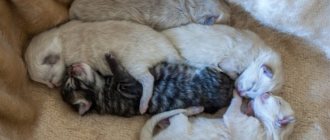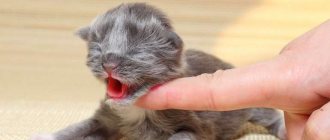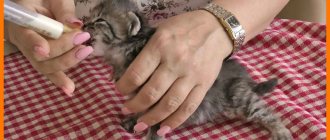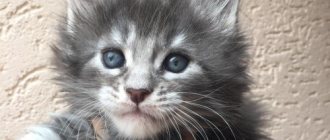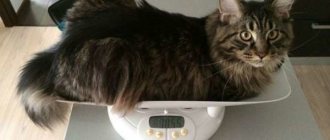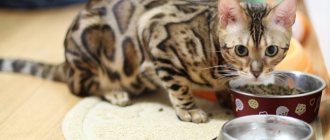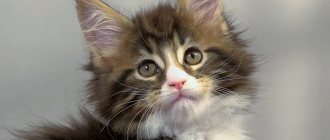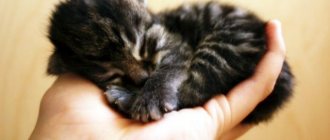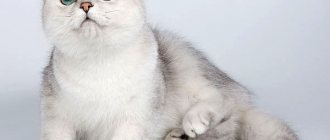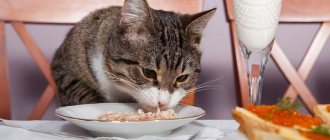In the article, we looked at the questions that owners have when introducing complementary foods to kittens. What is the best time to start complementary feeding, how and what to feed newborn kittens and kittens from one to three months. From the material you will learn which foods are prohibited for kittens to eat and why water is important for the health of the animal.
For the first three to four weeks of life, kittens feed on the milk of their mother cat. But over time, it becomes insufficient to develop properly, grow healthy and strong. At about the age of one month, kittens need to be introduced to complementary foods, which means they should begin to accustom them to adult food.
In order for kittens to grow up healthy and strong, you need to introduce complementary foods
Optimal time to start complementary feeding
Owners often have questions about when to start feeding kittens and what is best to feed them – natural food or ready-made industrial food.
Complementary foods can be introduced into the diet of kittens 20-21 days after birth. This procedure must be carried out up to six times a day, every 3-4 hours. Complementary feeding for kittens is usually started simultaneously with the consumption of mother's milk. Food is an addition; it must be soft, warm, and the portions are small, because babies have not yet learned to chew.
If you plan to feed your cat dry food in the future, you can make a paste out of it and give it to the kittens. The store sells special food for tailed babies of different breeds. Several pads are soaked in water and carefully spread on the kitten’s palate. Then a bowl of food soaked in water is placed in front of him. Gradually he must understand what is required of him. The amount of water added to the food should be gradually reduced, and by two months the baby will be able to chew the pads on his own.
When to start feeding?
There are no universal instructions on what to supplement kittens with and when to start feeding them. The answers to these questions largely depend on the breed of kittens, the pace of their development, growth and individual characteristics.
Note! If there are few kittens in the litter, the cat can provide their needs only with milk until the age of two months.
Feeding a suckling kitten
If a kitten is fed by its mother from the first day, it develops a fairly strong immune system, but there is no urgent need to switch to adult food. Being under the care of the mother, the kittens grow stronger physically and are in no hurry to try the proposed supplementary food, although they are clearly interested in it.
How to feed artificially
Sometimes cats, for some reason, abandon their kittens; they may not have milk to feed; tiny kittens can be found on the street or in the entrance. This is very dangerous for the lives of small animals, so you need to provide the kittens with care, care and proper feeding.
Only a human can help a defenseless kitten
Portion calculation
Complementary feeding for kittens left without a mother can be done using dry formulas that replace cat's milk, which are sold in pharmacies, or you can prepare a liquid mixture from natural products.
Milk replacers are sold in powdered and liquid forms. The powder is diluted with water as indicated on the packaging by the manufacturer. The unused portion is stored in the refrigerator. The mixture should not be allowed to freeze.
In the first seven days, the daily norm is 30 ml of formula per 100 grams of kitten weight. Further, until the age of two weeks, the amount of food increases to 40 ml per 100 grams of weight.
To replace cat milk, you can prepare several mixtures yourself:
- Dilute 250 grams of cream with 10% fat content with warm water in a ratio of 1 to 2;
- Mix a portion of goat milk with egg white in a ratio of 4 to 1 until smooth;
- Dilute condensed milk without sugar with water in a ratio of 5 to 1, add a teaspoon of bone meal to the mixture.
Raw cow's milk is contraindicated for newborn kittens; digestive problems may occur. You can use goat's milk for complementary feeding.
You can prepare your own formula for complementary feeding
Starting from the eighth day, kittens should be given liquid vitamin preparations prescribed by a veterinarian every other day.
The best food option for kittens is to use specially formulated cat milk replacers. The use of these mixtures practically guarantees the absence of problems with intestinal microflora in the future.
Rules for introducing complementary foods
There are general rules for feeding kittens that must be followed:
- Kittens are fed only in a prone position (natural) or held upright (with a weakened sucking reflex). A kitten may choke if placed on its back.
- Strictly control the gradual flow of the mixture, as the kitten may inhale excess liquid.
- You can feed using a pipette or a medical syringe without a needle. It is best to purchase a special bottle with a pacifier for kittens.
- The bottle should be held at a comfortable angle for the kitten, but not vertically or horizontally. The angle is approximately 45 degrees.
- After feeding, you need to massage the kitten's belly with a moistened piece of cloth or a damp sponge to stimulate digestion. This step cannot be skipped, because the kitten will not be able to go to the toilet and will suffer from intoxication. Under normal conditions, this is done by the mother cat. The kitten should relieve its natural needs 2-3 times a day.
- It takes about 5 minutes for a kitten to eat. If he sucks sluggishly and begins to fall asleep, it means he is full.
- Never force-feed leftover formula, even if your baby doesn't seem to have eaten enough. It is better to take a break and offer the pacifier again after 30–40 minutes.
- It is necessary to pay attention to the temperature of the food. Cold food disrupts digestion, hot food burns the oral cavity. From the first days of feeding, the temperature should be 37 degrees - an approximate indicator for the kitten’s body. Every week you need to lower this degree. By the end of the month, the mixture should be at room temperature - 24 degrees.
- Pipettes or bottles must be sterile; to do this, they must be boiled regularly.
It is better to feed babies with a bottle
Kittens' weight needs to be monitored. Slow growth indicates that the animals are malnourished. If kittens begin to suck the finger extended to them and squeak all the time, then they are hungry. Until about three weeks of age, they should gain 10-15 grams every day.
How often to give complementary foods
Kittens' diet changes almost every day. When feeding kittens with cat milk substitute formulas, you must follow the instructions on the package. Generalized recommendations for feeding frequency and portion sizes are as follows:
Days 1-4, the amount of mixture is 30 ml per 100 grams of weight every two hours around the clock.
Days 5-13, the amount of mixture is 38 ml per 100 grams of weight every 4 hours.
14-24 days the amount of mixture is 46 ml per 100 grams of weight every 4 hours. Formula milk can be poured into a saucer to encourage kittens to lap on their own. From the 15th day, kittens can be fed additionally.
25-35 days amount of food 53 ml per 160 grams of weight. During this period, it is necessary to feed the kittens with other foods and introduce solid food.
Failure to adhere to the feeding schedule can lead to health problems.
Breed characteristics of introducing complementary foods
It is very important to take into account breed characteristics and heredity if your kitten is purebred. Particular attention should be paid to kittens of popular and common breeds, since the risk of hereditary diseases is higher. In addition, kittens of popular breeds usually require strict control of weight gain.
Note! When preparing a diet for purebred kittens, it is customary to check the rate of weight gain with the breed table.
Pedigree kittens may refuse supplemental feeding until 1–2 months of age. However, if the baby has opened his eyes, but is absolutely not interested in the smell of food, it is better to consult a doctor. Kittens may ignore complementary foods due to helminthic infestation, sensitivity of the digestive tract, dysbacteriosis, food allergies, etc.
British and Scots
British and Scots are common breeds that are bred en masse. The experience of owners shows that most representatives of the breeds develop in a timely manner and are ready for supplementary feeding at one month of age.
Purebred cats and phenotypes often suffer from food allergies, so the first feeding should be as safe as possible. It is advisable to feed the kitten only natural products until the age of 4 months.
If your cat turns out to be allergic, it is better to consult a veterinarian. If it is impossible to identify the allergen, the pet will have to be switched to ready-made, hypoallergenic food.
Maine Coons
Maine Coons are the largest purebred cats. Representatives of the breed mature late, develop “slowly”, and stay with their mother for a long time. Mother cats fully care for their offspring until 3–4 months of age.
The timing of supplementary feeding is strictly individual. When the kittens begin to leave the nest, supplementary feeding is offered to them, but not forced. Babies should actively respond to the smell of food and have all their baby teeth. If kittens want, but cannot eat supplementary food, be sure to consult a doctor.
What to include in your diet
From the very first days of complementary feeding, owners need to choose a method of feeding the kitten and constantly adhere to it. In no case should you alternate natural products and industrial feeds - in this case it is impossible to maintain the optimal balance of vitamins and minerals, and an excess of any element can be no less harmful than its deficiency.
Throughout the cat’s life, you need to adhere to the feeding method chosen in childhood.
Diet of a kitten aged 1-1.5 months
Food for a 1 month old kitten should be similar in consistency to milk. Avoid hard foods and large pieces. The pet's body simply cannot digest such food.
New foods should be introduced into the diet every two to three days. The product is introduced gradually and in small portions.
Month-old kittens cannot control their food intake, so portion sizes must be observed. In addition, feeding too often can cause a negative reaction from the digestive system.
The list of products for a one-month-old kitten will be quite limited. The pet's jaws are not yet designed to chew large pieces of food, and the gastrointestinal tract is not able to digest many foods.
Veterinarians recommend starting complementary feeding for pets with liquid milk porridges, goat milk, low-fat cottage cheese, lean boiled meat or scraped raw meat.
At the age of 1-1.5 months, the average number of feedings per day should be 5-6 servings. For 100 grams of kitten weight you need to prepare 50-55 ml of prepared food.
In order to be sure that the kitten’s body receives all the necessary substances, you can buy additional vitamins and supplements. They should be selected after consultation with a veterinarian.
One-month-old kittens can be given goat's milk in small quantities.
A kitten that does not eat natural food should be fed high-quality ready-made food.
If the kitten will continue to eat ready-made dry or wet food, then it is necessary to start complementary feeding with them. Food must be chosen that is specialized for small kittens and takes into account the breed.
You need to start feeding kittens at three to four weeks of age. However, they must still receive breast milk or a milk substitute. Kittens need to be fed up to five times a day, every three to four hours. Portions should be small, and food should be warm and softened, since babies do not yet know how to chew.
Complementary feeding at 2 months of age
From two months, kittens can already eat more solid food. They still need to be fed 5-6 times a day in small portions.
At this time, the kitten’s diet may consist of liquid porridge (oatmeal, rice) cooked in milk, scraped meat, boiled vegetables (carrots, zucchini, pumpkin) in the form of puree or finely chopped with the addition of vegetable oil, kefir, cream, yogurt (natural , no additives or sugar).
The best meat for kittens at this age is lean beef, rabbit, chicken, and turkey. No more than once a week you can give offal: chicken and beef liver, heart. They are fed finely chopped or ground with porridge.
If you plan to switch kittens to dry or wet ready-made food, then this should be done after 2 months. The food must be of high quality and special for kittens.
Dry food should be specially selected for the age and breed of the kitten.
Nutrition for a 3 month old kitten
At three months of age, kittens’ skeletons become stronger, muscles grow, and teeth change. Kittens play and run a lot, exploring their surroundings. Therefore, they need an appropriate diet rich in nutrients and vitamins.
Three months is the age when it is time to finally switch the kitten to adult food. The number of feedings is reduced to 5 times a day.
The diet of a three-month-old kitten should include: raw meat (chicken, turkey, beef, rabbit), offal (liver, heart), porridge (oatmeal, buckwheat, rice), raw and boiled vegetables (carrots, cauliflower, zucchini, pumpkin), cream , kefir. You can introduce sea fish, no more than 2 times a month.
When choosing ready-made food, you should give preference to premium food. Food must be specially selected for the age and breed of the kitten.
Three month old kittens are very energetic and require a more nutritious diet.
Timely complementary feeding - why is it so important
From the first days of life, the kitten feeds exclusively on mother's milk. For the first three to four days, the cat produces not milk, but colostrum - a fatty, high-calorie diet containing vitamins, microelements, antibodies, a huge amount of beneficial lactobacilli and proteins.
Note! At about one month of age, kittens' growth reaches the stage when mother's milk cannot compensate for all the body's needs. During this same period, kittens' eyes open and they begin to become interested in the outside world.
Encouraging the curiosity of the babies, the breeder offers them complementary foods. Why is this so important? As soon as the kittens opened their eyes and began to leave the nest, their sense of smell and hearing began to become more acute. Within a month, babies will begin to see clearly, play and spend a lot of energy exploring the world.
Additional sources of proteins, carbohydrates and vitamins will help compensate for the sharply increased nutrient needs. In addition, at approximately one month of age, the active stage of bone growth begins, which creates an increased need for microelements.
Prohibited foods for the diet
It is recommended to exclude the following products from the kitten’s menu:
- milk and fatty dairy products;
- fried and salted foods;
- smoked meats and sausages;
- pork;
- River fish;
- potatoes, tomatoes, grapes, citruses, pineapple, kiwi;
- chocolate and bakery products;
- bones of animals, birds or fish;
- food from a person's table;
- dog food.
To prevent your kitten from eating prohibited foods, you need to follow these simple tips:
- Do not allow the kitten to sit on the table while preparing or eating food.
- Don't feed table scraps.
- During the holidays, be on your guard - scents can tempt even the most well-mannered and obedient animal.
- Keep food out of the kitten's reach. If he shows interest, install special locks on the cabinet doors.
Don't let the kitten sit on the table
Prolonged feeding of a kitten with human food leads to metabolic disorders, diseases of the gastrointestinal tract, heart and blood vessels.
Poor quality of the finished food or intolerance to a certain type can cause digestive problems in the kitten. In this case, you should consult a veterinarian and choose a different type of food or a different type and brand of food; it is better to give preference to products with a higher price. Saving on the animal's nutrition will negatively affect its health and will lead to even greater costs for the treatment of diseases that arise as a result of eating low-quality food.
Rules for feeding kittens
At what age are kittens given dry food? Reviews and opinions on this difficult issue are so diverse that you can’t imagine who to believe. If we assume that a conscientious manufacturer has put everything that is mentioned in the advertisement into the tin or bag of ready-made food, there is nothing terrible about “drying”. On the contrary, it’s incredibly convenient. But are you sure you should believe the advertising?
If you decide to feed your kitten “crackers”, pay attention to a few simple but mandatory rules.
Remember, either-or! This means that you cannot mix natural food and dry pieces. Never and under no circumstances! Store-bought food and food from a bag are digested differently. The stomach copes with the first on its own, but to digest the second, a large amount of liquid is needed. The kitten's stomach and intestines simply won't know how to work. As a result, you risk getting coprostasis or gastroenteritis. Before giving your kitten dry food, make sure that he ate “natural” food at least 3 hours ago.
Do not feed your animal mass market products. These are cheap foods that are sold in the nearest supermarket. This is equivalent to feeding your own child hot dogs and hamburgers all the time. Buy the highest quality food. Such food is unlikely to save your money, but it will protect your pet’s health from various diseases.
Don't experiment on your furry friend. Choose a brand of food once and for all. By mixing food from different brands, you will get an unimaginable “blend”. Using this method of feeding, you risk introducing an imbalance into the animal’s body. Exceeding the norm of calcium or, for example, amino acids will not bring anything good to your pet.
Water in the diet
The process of transitioning from cat milk or milk replacer involves gradually increasing your drinking water intake. Water is very important to keep kittens healthy and active. At about 4 weeks of age, as soon as the kittens begin to eat solid food, they need to have access to clean, fresh water.
It is advisable not to use a plastic bowl; it should be made of metal, glass or porcelain. It is better to place the bowl a little away from the place where the kittens eat. You can place several bowls of water throughout the apartment. A good solution would be to purchase a special drinking fountain.
Water is very important for a kitten's health
Important nuances
It is important to properly organize the feeding process itself; it is worth preparing for the first feeding. It is necessary to decide where exactly the four-legged will have a place where he can eat. Over time, the baby will remember exactly where his bowl is and where he should eat. It is important that at the age of a month the baby learns to eat from a bowl. Provide your child with free access to this place and try to keep it clean.
Feeding kittens is a responsible task, since the young animal’s body is not yet adapted to normal food. You need to use the basic rules.
Features of complementary feeding of individual breeds
When introducing complementary foods and preparing a diet, you need to take into account the characteristics of cat breeds. For most species, standard rules apply. But there are breeds that have certain characteristics that require correction in the complementary feeding regime.
Ragdoll kittens have a genetic disease: hypertrophic cardiomyopathy (thickening of one of the walls of the heart ventricle) and joint dysplasia. Therefore, the list of prohibited products additionally includes: meat of geese and ducks, cream, and fatty sour cream. Their consumption negatively affects cardiac activity and disrupts metabolism.
Little ragdolls
Sphynx kittens (like other representatives of hairless breeds) have a high risk of developing cardiovascular diseases. They can only be given dietary meat: turkey or chicken, rabbit, beef. Pork should not be given to any cats, and especially not to sphinxes. To start feeding, raw or boiled veal is suitable.
A Sphynx kitten needs to be fed more often than a regular cat. Six to eight meals are recommended up to two months, four meals up to five months. At the age of six months, reduce the frequency of feedings to three times a day, and from the age of nine months, accustom them to two meals a day.
Sphynx kittens
Maine Coons mature late. Cats usually feed their babies for up to two months. These kittens do not need to be fed complementary foods until they are 8 weeks old.
Maine Coon kittens differ from all others in their large size. Accordingly, more food is needed. At the age of two months, kittens should receive 130 grams of meat, up to 40 grams of vegetables and dairy products, and about 15 grams of cereal. For other breeds, this is the norm for an adult cat.
Maine Coon kittens are larger than kittens of other breeds
Dry food: can it be given to kittens and at what age is it best to do so?
The question of whether kittens can be given dry food remains open to this day. Veterinarians and felinologists give various arguments both for and against. Each owner must decide for himself what to feed his pet . You can start feeding kittens after a month of life, it is at this time that they begin to gnaw various objects (slippers, wires, etc.) with their newly erupted baby teeth.
It is believed that kittens need to be fed dry food when they begin to chew on everything.
Features of the composition of feeds of different classes for kittens
Just like food for adult felines, ready-made dry food for babies is divided into groups or classes that differ in quality and cost:
- Economy class Products of the lowest price category, the meat component in which, as a rule, does not exceed 5–6%. The main components are offal, meat and bone meal and other waste from the meat industry. The source of protein in such feeds are plant ingredients (rice, wheat, corn, etc.). To increase the volume, manufacturers add cellulose, which does not carry any nutritional value. The vitamin and mineral content is small.
- Premium class. A common group of feeds characterized by a higher content of natural meat (15–22%). All components (meat by-products, fish, etc.) used in production are specially selected and have appropriate veterinary certificates. The composition of such products is well balanced, containing the optimal amount of proteins of plant and animal origin with a high degree of digestibility, as well as the required vitamins and minerals. The percentage of preservatives, as well as dyes and flavors is insignificant.
The most popular group of premium feeds is
- Super premium class. A more expensive category, characterized by balance and a higher meat content of about 36–43%. Only high-quality ingredients are used in production (turkey, salmon, chicken, lamb, eggs, rice, etc.). The ratio of proteins, carbohydrates, fats is optimal, and the complete vitamin and mineral complex meets all the essential needs of animals. The energy value of this balanced diet is much higher, but it also costs more.
- Holistic class. The best elite food for cats, intended for expensive purebred and exhibition animals. Consists exclusively of natural and environmentally friendly (non-GMO, etc.) ingredients. The share of meat is at least 50–60% (lamb, beef, chicken, rabbit, etc.) . The food does not contain any preservatives or dyes, has excellent taste and excellent digestibility.
Our previous cat, who was picked up under the fence, could not eat cheap food like Whiskas. He could not digest these granules at all and caused severe digestive upset. Even this, one might say, sub-fence cat ate food no lower than premium class.
Advantages and disadvantages of dehydrated food for kittens
The positive aspects of using dry food in the diet of kittens are as follows:
- Significant time savings. Especially compared to natural feeding, because there is no need to prepare fresh food every day.
- Ease of use. Simply pour the granules into a bowl .
- A balanced and correct composition, which contains all the vitamins and minerals a kitten needs. In the case of natural food, the animal must be given vitamin and mineral supplements.
- Dry food does not spoil for a long time. If the owners are absent for a long time, it can be safely left to the pet for several hours. Wet canned food should be fed immediately.
- Long shelf life.
- Ease of dosage. Each package indicates the amount of food needed for one meal, so it is difficult to overfeed a kitten.
- A large assortment.
- Infection with helminths, as well as poisoning that is likely when a kitten eats raw foods, is excluded.
The main advantage of dry food is its ease of use; you just need to pour it into a bowl.
Negative characteristics include:
- Risk of dehydration. Dry food contains very little moisture, so the animal may not receive enough fluid (even if it drinks water often).
- Threat of tartar formation due to insufficient load on teeth.
- Cheap, low-quality food contains excess amounts of carbohydrates, which can lead to the development of diabetes.
The kitten must have access to water
Widely advertised economy class meals are addictive, as manufacturers add special flavor enhancers to them.
What is the difference between food for adult cats and food for kittens?
Veterinarians strongly do not recommend giving small kittens food for adult animals, because the energy value of such food is much lower than what is required by a young growing organism . The amount of calories and nutrients consumed may be insufficient for the full growth and development of the baby, which can lead to various diseases. The kitten must receive food in strict accordance with the biological needs of its age.
The size of food pellets for kittens and adult cats is very different.
In addition, granules from adult food are much larger and have greater hardness . It is sometimes very difficult for a small kitten to chew them, since they hardly fit into his mouth. He might even choke.
Feeding inappropriate food can lead to serious problems with the kitten's digestive system.
General recommendations
If it is decided that the kittens will eat only natural food, it is advisable to accustom the pets to eating a variety of foods from the first month. You should not give your animal one product he loves and make it the main one in his diet. This can lead to digestive problems.
A great danger to a kitten's health is feeding human food in combination with ready-made food. It is also not recommended to mix expensive dry food with cheap wet food. It is better to leave only dry food, since low-quality wet food will do nothing but harm to the kitten.
Pay attention to the kitten’s fur as often as possible: if it is shiny and smooth, then the pet is healthy. If bald spots appear or the skin under the fur is irritated, you need to consult a veterinarian and purchase a special vitamin complex. But remember that in a good ready-made food, all nutrients and microelements are already balanced.
Diet for feeding kittens
The rules for compiling a diet for feeding directly depend on the method of feeding the kitten. If babies fed on mother's milk, it is better to give them natural supplements. When artificially feeding with ready-made milk formulas, it is better not to change the type of diet, that is, the fattening diet is made up of industrial products.
Note! If you fed your kitten with formula prepared at home using whole milk, the supplementary diet is made up of natural products.
Industrial feed
To feed a kitten, you can use industrial food, but do not forget that the diet should be based on milk. The baby’s digestive system cannot digest food of different textures, so it is better to use industrial milk substitutes:
- Katzenmilch – possible from day one.
- Hartz milk powder.
- Babycat Milk (Royal Canin) - according to the instructions, it is possible only from 2 months, but the mixture can be used earlier if there are no alternatives.
- Beaphar Kitty-Milk.
- Gimpet Cat-Milk.
- Nutri Vet.
- Just Born.
- Nurturall-C.
- Pet Lac.
What a kitten shouldn't do
What to feed a one-month-old kitten: examples of self-feeding
Focusing on proper and balanced nutrition, it is also important to know what you should not feed your kitten.
These products include:
- Milk.
Cow's milk, to which people are accustomed, will be poorly absorbed by the kitten's body. It needs to either be replaced or diluted.
- Meat.
You should not give your kitten raw meat. Firstly, he is not yet able to chew and digest rough food, and secondly, raw meat may contain worms and pathogenic bacteria.
- Fatty food.
Cheeses, butter or fatty meats will also be heavy food for a kitten and should be introduced into the diet gradually and little by little.
- Bones.
The kitten is not able to thoroughly chew and digest such foods on its own.
- Sweet.
What a cat shouldn't eat
Firstly, the enamel of cats' teeth is 10 times thinner than that of humans and, when ingested by sweets, is less resistant to the effects of sugars. Secondly, sweets are a very high-calorie food for cats, which can disrupt their digestion.
- Bakery products.
Poorly absorbed by the body: it causes colic and flatulence.
- Mixed diets.
You only need to choose one type of food: a specific brand of food or a homemade balanced diet.
- Rice porrige.
Causes disruptions in the gastrointestinal tract.
- Tomatoes, potatoes, eggplants.
Contain substances that are considered toxins for the cat's body. They are not digested properly, either cooked or raw.
- Fruits.
They contain a large amount of sugar, which is harmful to the kitten. May cause an allergic reaction.
- Leguminous plants.
Not absorbed by the cat's body.
- Monotonous food.
When eating monotonous food, the kitten does not receive all the necessary vitamins and minerals in the required quantities. The diet should be varied, taking into account the characteristics of the growing organism.
If there are both cats and dogs in the house, the food should be different, as they have different compositions. Under no circumstances should a kitten be given food intended for dogs.
How to choose dry food for a “cat-baby”
There is only one option when you can feed your kitten dry food. Products must be extra-premium. If you think that feeding your pussy “crackers” is cheap and not particularly troublesome, you are mistaken. Good food is very expensive. Even if you buy turkey meat that is not too budget-friendly to feed your animal, it will still be cheaper.
To determine the quality of purchased food, look at the label. The first five ingredients listed must be natural products. Even foods such as the well-known Royal Canin are not preferred. Of course, there will be no harm from them. But your kitten will not receive adequate nutrition.
There is an opinion that feeding a kitten with natural products takes too much time. This is completely wrong. It may indeed be difficult for you at first. But by the end of the first month, everything will definitely improve and providing proper nutrition to your pet will no longer take so much time.
Have you decided to focus on bagged food? Try these:
- Hill's Science Plan Puppy & Kitten.
- Orijen Cat-Kitten Formula.
- Eukanuba Puppy & Junior Small Breed.
- Chicken Soup Kitten Formula.
- Royal Canin Size nutrition Mini Junior.
Most of the ingredients in these foods are truly natural. Your kitten will receive all the necessary minerals and vitamins.
There is also a list of “crackers” that should never be fed to kittens. Undesirable trademarks include:
- Whiskas.
- "Katinka".
- "KitiKat."
- "Friscas" and some others.
